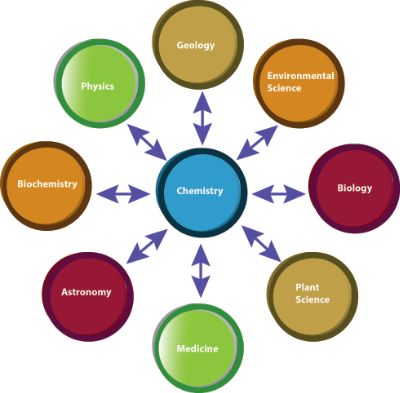Click here to watch the video on Chemistry and Matter
Chemistry is essential to all of the other sciences, therefore, it is referred to as the central science.
Chemistry is the study of matter–its nature, its properties, and its transformations. Matter is the material that makes up our wonderful universe–anything that has mass and occupies space (volume). The chair you are sitting in, your hair, the air you breathe, the foods you eat, the trees, and your car are all examples of matter. Heat and light are not matter, but are forms of energy and will be discussed in detail later on.Chemists study the properties of matter–both physical and chemical. A property is a characteristic that is useful for identifying matter. Some Physical properties include size, color, density, conductivity, and boiling point. Chemical properties include chemical reactivity, flammability, toxicity. Properties can be further classified as extensive or intensive. Extensive properties are dependent on the amount of matter. For example, mass, volume, heat transfer, etc., are extensive properties. Intensive properties are not dependent on the amount of material present. Examples are melting point, density, coductivity, malleability, color, etc.
We look at both chemical and physical changes. A physical change is one that does not alter the identity of a substance, whereas a chemical change (chemical reaction) produces a new substance(s). One example of a physical change is when an ice cube (solid H2O) melts to give liquid water (liquid H2O). Only the form of the water (H2O) has changed, not the chemical makeup. If we lower the temperature, the liquid water will freeze to give ice (solid H2O)–the physical change is reversible when the temperature is changed. On the other hand, when a car rusts, we have a chemical change. The iron reacts with the oxygen in the air to give rust which is a new substance. We observe a chemical change (chemical reaction). A new substance has been formed,Fe2O3·nH2O. More about chemical changes later.
Click Here for the Chemical and Physical Changes Worksheet
Click here to watch the video on Chemistry and Matter
Click the link below to take a quiz on matter.
Go to Next Topic: Measurements, Metric System and SI Units
Go Back to Study Guide List for General Chemistry 1
Go to Home Page
Go To Video List

